Municipal engineers don’t exactly have reputations for being devil-may-care, live-on-the-edge risk takers. Speaking generally, they work hard, take their jobs seriously, and really really want their projects to work. Collapsed bridges and over-flowing sewers don’t look so hot on the resume.
But stormwater engineers in Gresham, a neighbor to Portland, and Issaquah, located in the foothills of the Cascades outside Seattle, have built some interesting — even a touch experimental — roads and parking lots using permeable pavement.
The main reason for using permeable pavement, which comes in two basic flavors: porous asphalt and pervious concrete, is to help shrink and clean polluted stormwater runoff. Instead of sheeting off pavement with a slug of toxic chemicals, rainwater trickles through pores in the pavement, soaking into the gravel and native soils below. In addition to treating stormwater, the pavement is safer for drivers because it reduces hydroplaning and the glare from wet pavement. Plus, it can save money by eliminating the need for traditional, costly stormwater pipes and retention ponds or vaults.
Permeable pavement is increasingly being turned to as a “green” technology for managing dirty stormwater, but the truth is, it’s still an approach that’s under development.
That’s why it’s interesting to see these two smaller cities tackling projects that stretch into uncharted territory for the Northwest. In Gresham, the city installed porous asphalt on a sloped road with less-than-perfect soils — two factors that tick up the degree of difficulty. Issaquah built a 1.5 acre porous asphalt parking lot at a formerly unpaved site that was so poorly drained, it was known for its muddy potholes.
“Everyone’s cautious on the public side,” said Steve Fancher, director of Gresham’s Department of Public Works. “You don’t want those failures.”
There are countless success stories in the world of permeable pavement, but there are many cautionary tales as well (see Appendix D, Permeable Pavement Literature Review). The water-loving pavement sometimes breaks down faster than conventional roads, shedding rocks in a process called “raveling” or “scuffing” depending on how large of an area is losing rocks. It can get clogged with dirt and other debris, or even grow moss, making it less effective at letting rain and melted snow pass through it.
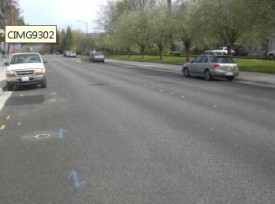
But when it works — and most of the time it does — it’s whiz-bang cool. Water simply vanishes from the surface of the pavement. There are videos and photos of fire hoses gushing over pervious concrete and the water is sucked up like it’s being poured onto a damp rock sponge. The water seeps back into the earth and into hidden stores of groundwater. No more shoe-soaking mud puddles or standing water to drench windshields and blind drivers.
Between a road and a hard place
Though permeable pavement has been around for decades, cities, counties, and developers have been sparing in their use of it. Most of the time, permeable pavement has been installed in flat areas with super well-draining soils, and in places where there are low volumes of slow moving traffic such as residential streets, parking lots, and bike and walking paths.
But not always.
Gresham, a city of 100,000 that’s en route to Mount Hood from Portland, has adopted a strict policy for using green stormwater solutions as much as possible. They’ve turned to green technologies because of their cost savings both in construction and long-term maintenance, and for the environmental benefits to streams and salmon.
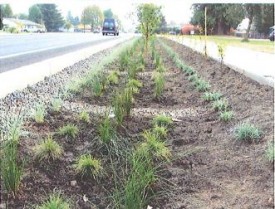
So when the city decided to widen a congested two-lane arterial to four lanes, their engineers had to get creative. There was room for rain gardens along the shoulder for some stretches of Kane Road, but not everywhere given that traffic lanes were being widened. Some of the water needed to go under the road.
“We knew we needed to reduce the water as much as we could and slow it down, but the options were very limited,” Fancher said. “It’s an extremely challenging site.”
Many permeable pavement guidelines warn against using the material on sloped sites for fear that the water can run downhill, pool up, and seep back through the pavement to the surface rather than soaking into the ground. The soils under Kane weren’t great either.
Luckily, Fancher had experience with the technology, working on some of Portland’s first permeable pavement projects in 2004 and ’05. And Gresham had installed some green stormwater technology as well, so there was some level of comfort within the city.
After carefully and thoughtfully investigating their options, the city approved a plan to build three rain gardens along the 1,000 foot roadway where room allowed. They also built a new storm drain under the center of the road. And about half of Kane was paved in porous asphalt.
“This was probably the boldest porous pavement job I’m aware of,” Fancher said.
Razing Kane
To improve their likelihood of success, the engineers opted for an 18-inch thick gravel base under the road to maximize the space to hold water and to support a road that will get heavy traffic. Other porous asphalt projects built in better conditions can get away with a foot of gravel or maybe less. The city also took the step of building impervious clay dams and rock trenches at points under the road to prevent all of the water from running downhill. The dams would force the water to soak into the ground along length of the street.
Construction on Kane Road was done in the summer of 2010. How did it turn out?
“It seems to be performing really well,” Fancher said. “There’s been some minor raveling.” But there hasn’t been any rutting, he said, which is when tires form troughs in the road.
The rain gardens and porous road combined are handling the polluted runoff from more than 2.6 acres of pavement, preventing 1.5 million gallons of filthy stormwater from fouling nearby Kelly Creek each year.
Roads in this Oregon city were already being swept 10 times a year as a part of their standard maintenance program, making it more likely that the street will stay clean and keep soaking up the rain as designed.
And the neighbors love how quiet the street is. Research has shown that permeable pavement is typically quieter than normal streets, and in fact pervious concrete is an effective material for building sound-barrier walls along highways.
Fancher is still waiting to see how the road performs over the long haul. Studded tires and chains are among asphalt’s worst enemies, and they’re sure to be found on vehicles headed from Portland to Hood.
“It’ll be a true test,” he said.
Paving the porous way
In 2007, Issaquah installed its first major permeable pavement project. Rainier Boulevard was severely deteriorated and needed to be rebuilt. When the Washington Department of Ecology dangled some dollars through its green stormwater grant program, officials decided to take a chance on porous asphalt.
“In that part of town, there were good soils for infiltrating water,” said Kerry Ritland, senior water resources engineer for Issaquah. “There wasn’t any question whether it would work or not.”
The street wasn’t a main arterial, but it still got a lot of traffic. In addition to the 520-foot stretch of porous asphalt, the city built two rain gardens to help control stormwater runoff.
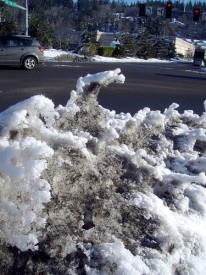
The project worked great. For a while. But Issaquah and its 30,000 residents are flanked by mountains on three sides, and the city is aggressive in sanding roads — including Rainier.
“It got a good dose of sand on it,” Ritland said. “Road sand is pretty low grade stuff. It’s pretty dirty.”
Unfortunately, sand is one of the worst things to dump on permeable pavement, and after four years of sanding, the boulevard got plugged up. It was no longer draining as designed. The city tried a few methods of cleaning the street and recently came up with a solution. For $6,000, a contractor spent a day or two pressure washing Rainier with a rotary head cleaning device.
Porousness was restored.
“That blasted it out and it’s working great again,” Ritland said.
Better parking in Central Park
Following that project, the city decided to tackle a spot with trickier soils that don’t soak up the water as well or as fast. The soil in the unpaved parking lot in the Issaquah Highland’s Central Park was so non-absorbent and compacted that it was plagued with muddy potholes.
To solve the problem, last summer the city built a 1.5-acre porous asphalt lot with 163 parking spots. Ritland said they used a thicker layer of gravel to help the water drain. The project, which again was supported in part with grant money from Ecology, included an 8,200-square-foot rain garden.
Between the state grant money and the cost savings from not having to build large, expensive stormwater detention systems, the porous asphalt made economic sense, Ritland said.
But these projects still push people outside their comfort zone. Will the water drain fast enough, or will it seep back through the pavement or cause the asphalt to fail? Will it stand the test of time?
Because even though conventional roads are certain to fail over time, are known to create buckets of polluted runoff that poison natural waterways, the public tends to hold new technology to a higher standard. That puts the pressure on those proposing green solutions that include permeable pavement.
As Ritland explained: “It’s hard to tell exactly what is going on underground.”
Proceed with caution
While Fancher and Ritland are ready for more permeable pavement projects in their future, they agree that the technology is still being perfected. They offer words of advice and caution to those who are promoting and testing out porous asphalt and pervious concrete.
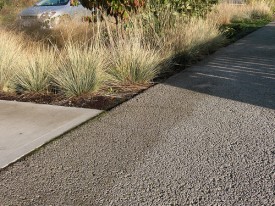
Ritland said he would like the use of permeable pavement to be driven by incentives rather than mandates. He worried that new stormwater permit rules being proposed by Washington state will too stringently require the use of unconventional pavement and other green technologies. He wants to see enough flexibility in the regulations to make sure the green strategies are used wisely.
“You could get into difficult situations where it doesn’t make any sense,” Ritland said. In some places it works, “in others, it’s an expensive experiment.”
Fancher suggested that interested cities and counties go slow in adopting the technology. He recommended that they start out with small permeable pavement projects that are done internally. That way, city and county employees get some experience doing the design work and develop some ownership in the projects. The approach can help them feel more comfortable and confident.
“It’s a good thing to be cautious,” he said, “take small steps and have small successes.”
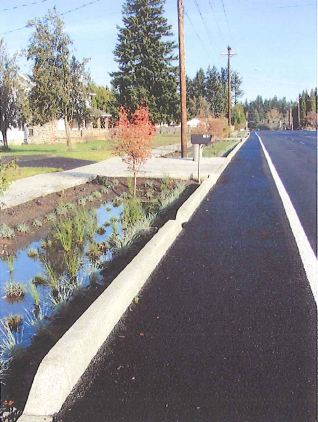

Comments are closed.